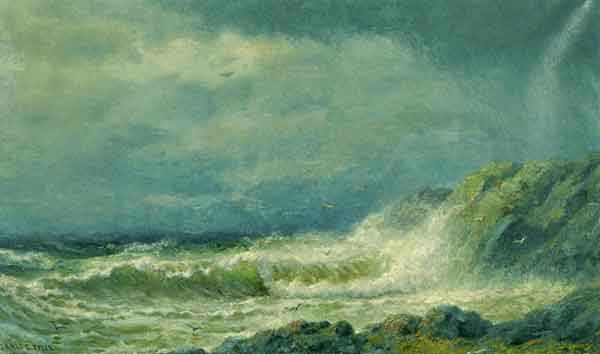|

JAMES GALE TYLER (1855-1931)
Rocky coastal scene. Signed ll, James G. Tyler".
Oil on canvas, 18" x 30". Framed. 23 x 35
SOLD
One of America’s foremost marine artists, James Gale Tyler was born in Oswego, New York in 1855. His interest in marine subjects began early, as by age 15 he was showing fascination with the ocean and seagoing vessels. He moved to New York City where, studying with A. Cary Smith, he took his only formal art lessons. Tyler's signature painting became known for the emphasis on mood and impression rather than for detailed realism.
He got much of his subject matter from his yearly travels between 1900 and 1930 to Newport, Rhode Island to paint scenes from the America's Cup Race. Many important illustration commissions as well as painting requests came his way during his lifetime. Among his illustration clients were publishers of Harper's, Century and Literary Digest. Tyler worked in New York and Providence, Rhode, Island in the mid 1880s-1890s, but it was Connecticut where he primarily worked and lived from 1870 until his death in 1931 at Pelham, New York. In addition to other marine scenes, Tyler painted every America’s cup race from 1900 to 1930. About his career, it was written that "No aspect of maritime life escaped Tyler's attention. In addition to painting all types of boats-from old sloops to clipper ships-he painted a variety of seamen, coastal scenes and seascapes."
He was a member of the Brooklyn Art Club, Artists Fund Society, Greenwich Society of Artists and the Salmagundi Club. He exhibited extensively at the National Academy, the Providence Art Club, the Boston Art Club and the Brooklyn Art Association and the PAFA. His work is in permanent collections at the Corcoran Gallery, Washington, DC; Tokyo Museum; Wadsworth Athenaeum, Hartford, CT; Omaha Museum of Art, NB; Mariner’s Museum, N.Y. Historical Society and elsewhere. James Tyler was primarily a resident of Greenwich, Connecticut, but the year he died, 1931, he moved to Pelham, New York. Tyler’s paintings are effused with subtle effects of light, vibrant color, and careful detail. It is for these reasons that Tyler’s paintings were extremely popular during his lifetime and continue to be popular today.
Source:
American Art Analog, Volume II, compiled by Michael David Zellman in association with American Art Analog, 1986, p. 513
|
|

